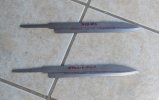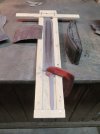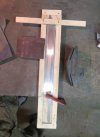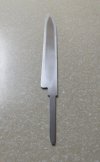- Joined
- Apr 13, 2017
- Messages
- 2,123
Greetings all, I have been asked by my retired business partner to make him a yanagi ba. I've never made kitchen cutlery but plenty of outdoor styles. I've done a fair bit of research here, including Master Stacey's WIP from 2012 (can post a link if you want). That handle is a masterpiece.
I'm planning (only in my head so far) on about 7.5-8" blade with 4.5-5" handle, plungeless grind, chisel ground on the right with very long belly and long convex clip. Sort of like this commercial one from the big web:
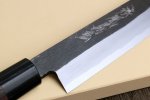
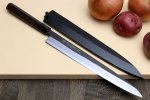
I'm leaning toward an octagon handle with ebony up front, then leopardwood and ebony pommel all held with internal pins (need to learn the proper Japanese terms for these handle components). I'll be visiting a sushi place here to examine a professionally used version pretty soon.
So I have several questions:
Steel Choice: I'm thinking 1.25" tall is about right? Should I go 1/8" or 5/32"? What type of stainless and carbon would be good choices? I'm leaning towards carbon since I know the customer will take good care of it and have read it can get sharper than SS. I'm going to get 48" bar stock so I can make about 4. I usually hand sand after 220 belt grind up to about P400/600 prior to HT, then I might take it to p1500 or p2000 afterwards.
Edge thickness pre HT: is .02 too much? how thin can I go without risking edges warping in HT for a given steel choice?
Edge post HT: is less than .01" behind the edge capable of getting sharp enough to do the work? Is there a benefit for a secondary tiny bevel on the left side as well?
Wooden case: what's the name of the wooden sheath again? I need to write stuff down more.
Thanks in advance for the valuable help.
I'm planning (only in my head so far) on about 7.5-8" blade with 4.5-5" handle, plungeless grind, chisel ground on the right with very long belly and long convex clip. Sort of like this commercial one from the big web:


I'm leaning toward an octagon handle with ebony up front, then leopardwood and ebony pommel all held with internal pins (need to learn the proper Japanese terms for these handle components). I'll be visiting a sushi place here to examine a professionally used version pretty soon.
So I have several questions:
Steel Choice: I'm thinking 1.25" tall is about right? Should I go 1/8" or 5/32"? What type of stainless and carbon would be good choices? I'm leaning towards carbon since I know the customer will take good care of it and have read it can get sharper than SS. I'm going to get 48" bar stock so I can make about 4. I usually hand sand after 220 belt grind up to about P400/600 prior to HT, then I might take it to p1500 or p2000 afterwards.
Edge thickness pre HT: is .02 too much? how thin can I go without risking edges warping in HT for a given steel choice?
Edge post HT: is less than .01" behind the edge capable of getting sharp enough to do the work? Is there a benefit for a secondary tiny bevel on the left side as well?
Wooden case: what's the name of the wooden sheath again? I need to write stuff down more.
Thanks in advance for the valuable help.

